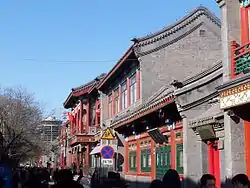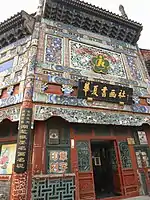

Liulichang (simplified Chinese: 琉璃厂; traditional Chinese: 琉璃廠; pinyin: Liúlíchǎng) is a district in downtown Beijing that is known for a series of traditional Chinese stone dwellings selling various craftwork, artistry, and antiques. It is one of Beijing's traditional old quarters.
History

The name Liulichang dates back to the Ming dynasty, when a renowned coloured glaze factory called "Liulichang" was in production on this street, which made glazed tiles for the palaces, temples, and residences of the officials.[1]
According to local tradition, during the Ming and Qing dynasties, Liulichang was a favourite haunt for scholars, painters, and calligraphers who gathered there to write, compile, and purchase books, as well as to paint and compose poetry. By the Kangxi era (1661–1722) of the Qing dynasty, Liulichang had become one of the most flourishing cultural centres in all of Beijing.[2]
Renovations
Large-scale renovations in modern times have transformed Liulichang into an antique market that resembles a Chinese village. Shops located on the street have a variety of Chinese folk arts such as paintings, calligraphy, pottery, carpets, vases, books, scrolls, and chops.
Today the street is a mixture of state-run and privately owned shops, and customers are recommended to bargain before making purchases. There are also traditional teahouses and wineshops, as well as many restaurants.[3]
It is a popular destination for tourists who wish to experience the commercial aspect of popular Chinese folk artwork in Beijing without the bustling traffic.
References
- ↑ "Liulichang Cultural Street". Travel China Guide. Archived from the original on 29 June 2017.
- ↑ "Liulichang -- Antiques Street". China Internet Information Center. Archived from the original on 19 May 2018.
- ↑ "Liulichang Street". China Travel. Archived from the original on 28 August 2016.